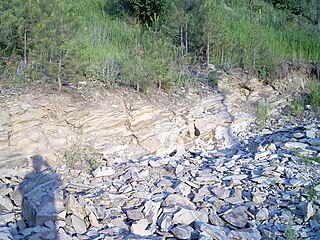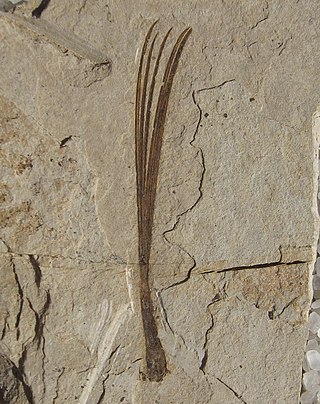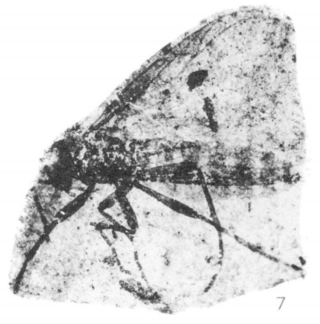Driftwood Canyon Provincial Park is a provincial park in British Columbia, Canada. Driftwood Canyon Provincial Park covers 23 ha of the Bulkley River Valley, on the east side of Driftwood Creek, a tributary of the Bulkley River, 10 km northeast of the town of Smithers. The park is accessible from Driftwood Road from Provincial Highway 16. It was created in 1967 by the donation of the land by the late Gordon Harvey (1913–1976) to protect fossil beds on the east side of Driftwood Creek. The beds were discovered around the beginning of the 20th century. The park lands are part of the asserted traditional territory of the Wet'suwet'en First Nation.

The Klondike Mountain Formation is an Early Eocene (Ypresian) geological formation located in the northeast central area of Washington state. The formation is comprised of volcanic rocks in the upper unit and volcanic plus lacustrine (lakebed) sedimentation in the lower unit. the formation is named for the type location designated in 1962, Klondike Mountain northeast of Republic, Washington. The formation is a lagerstätte with exceptionally well-preserved plant and insect fossils has been found, along with fossil epithermal hot springs.

The Allenby formation is a sedimentary rock formation in British Columbia which was deposited during the Ypresian stage of the Early Eocene. It consists of conglomerates, sandstones with interbedded shales and coal. The shales contain an abundance of insect, fish and plant fossils known from 1877 and onward, while the Princeton Chert was first indented in the 1950's and is known from anatomically preserved plants.
The Coldwater Beds are a geologic formation of the Okanagan Highlands in British Columbia, Canada. They preserve fossils dating back to the Ypresian stage of the Eocene period, or Wasatchian in the NALMA classification.

Hiodon woodruffi is an extinct species of bony fish in the mooneye family, Hiodontidae. The species is known from fossils found in the early Eocene deposits of northern Washington state in the United States and late Eocene deposits in northwestern Montana. The species was first described as Eohiodon woodruffi. H. woodruffi is one of two Eocene Okanagan Highlands mooneye species, and one of five fish identified in the Klondike Mountain Formation.

Pinus latahensis is an extinct species of conifer in the pine family Pinaceae. The species is known from fossil leaves found in the early Eocene deposits of northern Washington state, United States, and southern British Columbia, Canada.

Comptonia columbiana is an extinct species of sweet fern in the flowering plant family Myricaceae. The species is known from fossil leaves found in the early Eocene deposits of central to southern British Columbia, Canada, plus northern Washington state, United States, and, tentatively, the late Eocene of Southern Idaho and Earliest Oligocene of Oregon, United States.

Amia? hesperia is an extinct species of bony fish in the bowfin family, Amiidae. The species is known from fossils found in the early Eocene deposits of northern Washington state in the United States and southeastern British Columbia. The species is one of eight fish species identified in the Eocene Okanagan Highlands paleofauna.

Barghoornia is an extinct genus of flowering plants in the family Burseraceae containing the solitary species Barghoornia oblongifolia. The species is known from fossil leaves found in the early Eocene deposits of northern Washington state, United States.

Equisetum similkamense is an extinct horsetail species in the family Equisetaceae described from a group of whole plant fossils including rhizomes, stems, and leaves. The species is known from Ypresian sediments exposed in British Columbia, Canada. It is one of several extinct species placed in the living genus Equisetum.

Fagus langevinii is an extinct species of beech in the family Fagaceae. The species is known from fossil fruits, nuts, pollen, and leaves found in the early Eocene deposits of South central British Columbia, and northern Washington state, United States.

The Eocene Okanagan Highlands or Eocene Okanogan Highlands are a series of Early Eocene geological formations which span a 1,000 km (620 mi) transect of British Columbia, Canada, and Washington state, United States. Known for a highly diverse and detailed plant and animal paleobiota the paleolake beds as a whole are considered one of the great Canadian Lagerstätten. The paleobiota represented are of an upland subtropical to temperate ecosystem series immediately after the Paleocene–Eocene thermal maximum, and before the increased cooling of the middle and late Eocene to Oligocene. The fossiliferous deposits of the region were noted as early as 1873, with small amounts of systematic work happening in the 1870–1920s on British Columbian sites, and 1920–1930s for Washington sites. Focus and more detailed descriptive work on the Okanagan Highland sites started in the late 1960s.
The paleofauna of the Eocene Okanagan Highlands is comprised of Early Eocene arthropods, vertebrates, plus rare nematodes and molluscs found in geological formations of the northwestern North American Eocene Okanagan Highlands. The highlands lake bed series' as a whole are considered one of the great Canadian Lagerstätten. The paleofauna represents that of a late Ypresian upland temperate ecosystem immediately after the Paleocene-Eocene thermal maximum, and before the increased cooling of the middle and late Eocene to Oligocene. The fossiliferous deposits of the region were noted as early as 1873, with small amounts of systematic work happening in the 1880-90s on British Columbian sites, and 1920-30s for Washington sites. Focus and more detailed descriptive work on the Okanagan Highlands site started in the last 1970's. Most of the highlands sites are preserved as compression-impression fossils in "shales", but also includes a rare permineralized biota and an amber biota.
Uhlia is an extinct genus of coryphoid palm containing a single species Uhlia allenbyensis. The species is known from permineralized remains recovered from the Princeton Chert in British Columbia, Canada. Leaves of Uhlia have "tar spot"-like fungal infections of the extinct ascomycete Paleoserenomyces, which in turn are hyperparasitized by the ascomycete Cryptodidymosphaerites.
Paleoserenomyces is an extinct monotypic genus of pleosporale fungus of uncertain family placement. When described it contained the single species Paleoserenomyces allenbyensis. The genus is solely known from the Early Eocene, Ypresian aged, Princeton Chert deposit of the Allenby Formation. Palaeoserenomyces is one of only three described fossil fungus species found in the Princeton Chert, being a tar spot like parasite of the fossil palm Uhlia allenbyensis, and is host for the hyperparasite Cryptodidymosphaerites princetonensis.
Cryptodidymosphaerites is an extinct monotypic genus of pleosporale fungus of uncertain family placement. When described it contained the single species Cryptodidymosphaerites princetonensis. The genus is solely known from the Early Eocene, Ypresian aged, Princeton Chert deposit of the Allenby Formation. Cryptodidymosphaerites is one of only three described fossil fungus species found in the Princeton Chert, and is a hyperparasite of Palaeoserenomyces allenbyensis, itself a tar spot-like parasite of the fossil palm Uhlia.
Eoseira is an extinct genus of diatoms belonging to the family Aulacoseiraceae and containing the single species Eoseira wilsonii. The species is dated to the Early Eocenes Ypresian stage and have only been found at the type locality in east central British Columbia.

Promastax is a genus of "monkey grasshoppers" belonging to the extinct monotypic family Promastacidae and containing the single species Promastax archaicus. The species is dated to the Early Eocenes Ypresian stage and has only been found at the type locality in east central British Columbia.

Plecia avus is an extinct species of Plecia in the March fly family Bibionidae and is solely known from Early Eocene sediments exposed in central southern British Columbia. The species is one of twenty bibionid species described from the Eocene Okanagan Highlands.

Polystoechotites is an extinct parataxon of lacewings in the moth lacewing family Ithonidae. The taxon is a collective group for fossil polystechotid giant lacewing species whose genus affiliation is uncertain, but which are distinct enough to identify as segregate species. Polystoechotites species are known from Eocene fossils found in North America and is composed of four named species Polystoechotites barksdalae, Polystoechotites falcatus, Polystoechotites lewisi, and Polystoechotites piperatus, plus two unnamed species. Three of the described species are known from fossils recovered from the Eocene Okanagan Highlands of Washington State, while the fourth is from Colorado.













